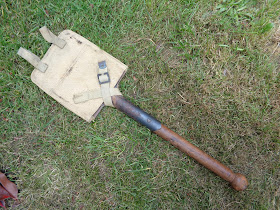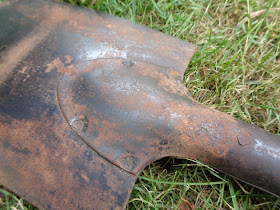I am always on the lookout for interesting, and rare shovels and covers to add to the collection. While doing a little "online exploring", I spotted a flat shovel with a canvas cover up for sale, by a seller in Ramat Yishay, Israel.
The price was high, and it was grouped with another civilian type of folding shovel. I made a number of offers, and kept in contact with the seller over several months. We eventually came to an agreeable price, for the flat spade and cover only, and a deal was struck. There was more than a bit of a language barrier to deal with, but I persevered. After over a month of shipping in-transit time, it arrived. I was not disappointed, but I also wasn't sure exactly what I bought!
I exchanged a few messages back and forth with the seller, and it sounds like this shovel, and carrier, were used by the Israeli Defense Forces (IDF, Zahal) back in the 1950's, and they were obtained by the seller after IDF service.
The subject of IDF entrenching tools (or any IDF equipment and uniform items for that matter), is a tough area to find any documentation on. I do most of my research by combing through old photos, looking for items being worn in the field by IDF soldiers. It is by no means the most efficient way to research, but when an item is spotted in a documented photo, there is no disputing its use!
The IDF was founded in 1948, after the Israeli War for Independence. From the moment Israel came into existence, they have been in one war after another with their Arab neighbors, and in a constant state of war alert at all times since. In fact, the IDF is considered one of the all time, most war hardened, and experienced, military forces in the world! You can read more about the IDF here:
The early Israeli Army was equipped with a mix of foreign surplus, donated items, and domestically made items. The British, French and Americans, donated large quantities of surplus items in the early days of the IDF. It is not uncommon to see photos of IDF soldiers wearing French Lizard camo, wearing French hats, and wearing British web gear, wearing US M1 helmets or British Brodie Helmets, carrying US M1943 folding shovels, and carrying surplus WW2 vintage K98k Mausers, or US M16 rifles! Tying all of that together, is a mix of hybrid Israeli designed and made gear. Collecting IDF equipment and uniforms is never dull! As the years went by, these foreign items were modified, repaired, and mixed together, until they became uniquely Israeli. That is exactly the case with the shovel and cover I acquired.
With that bit of background history behind us now, let's move on to the star of today's blog posting, my IDF shovel and cover.
Let's start with the cover, since that is by far, (in my opinion), the most interesting part of the pair. The cover is constructed out of heavy "British Web Fabric", with a British style buckle fastener, but it is definitely NOT British.
The style of the cover is distinctly "German" in design, but is NOT German. It has the classic belt loops at the top, and a wrap-around strap, in the old German style. The cover is also very reminiscent of the old British 1939 shovel cover, but when placed beside the British cover, it is easy to see the differences.
Here is a link to my British 1939 shovel and cover blog posting if you would like to see the comparison:
The British covers do not have belt loops, the corners are riveted, and there is no interior reinforcements.
What this shovel cover appears to be, is in fact, a French Engineer Corps, Pioneer, shovel cover. After consulting with fellow collectors and researchers, the consensus is that the cover is French made.
France was one of only a couple of western countries that continued to use the flat shovel after WW2. It appears that these flat shovels were used with the French Engineers, or Pioneer units. In the early post-WW2 years, France used various surplus fabrics and hardware to construct their early web gear. This would explain the use of British Web Fabric for this carrier. I have seen a French Engineer Department specification drawing from the 1950's that shows two covers specified for the flat shovels. One of the covers is remarkably similar to mine, and even has the same style of belt loops and British styled buckle.
You can read more about the photo above, and the early French covers on this French Forum (be warned, it is in French):
The later French covers of the 1960's and 1970's, are constructed in much the same way as my IDF cover, with a few differences. The rear hanger is the US wire type, for attaching to a web belt (the French used nearly identical belts as the US during the 1960's -1980's). The fasteners are usually cinch tighteners, similar to the US style, and the fabrics are standard French fabrics. You can see a good example on this French forum posting:
On one side of this IDF cover, there are faint, large, Hebrew letters written or stamped on it. Unfortunately they are too faded to read clearly. This is another clue to this cover actually being IDF issued.
Inside the cover, there is a leather "blade protector". The stitching has worn away, so now the leather insert is loose, but originally it was sewn in place. I have not seen a cloth cover with the internal leather protector like this before.
The cover is very heavy duty, and very well made. With the leather protector inside, I believe it was made for heavy, long-term field use. This would make sense if it is an early, post-WW2 French Engineer's cover.
Since France donated uniforms and equipment to Israel in the 1950's-1970's, and the cover matches the French Engineer shovel cover style, and construction, I am pretty sure that this is where the cover originally came from, before IDF use. The research continues!
The shovel is a mystery. There are no markings on it. The blade is crude and the two sides are "pinch welded" together. The handle has an odd, ball design, on the end, that I have not seen on any other flat shovel. The wood handle does not insert fully, to the end of the handle socket, and it is crudely riveted on.
Israel rebuilt and repaired old surplus gear that they obtained for service, so a replaced handle would make perfect sense. The handle appears to have been on the shovel for a very long time, and was was used for quite some time after installation.
I have not found any shovels that match the construction of the blade exactly, and the handle style is unique, so I have no definitive clues as to the origin at this point. The seller did say the shovel came with the cover, so I'm confident it was in IDF service, along with the cover.
So until I uncover more information, find a photo, or get additional information from fellow collectors and historians, we will have to leave this research as it stands today. Let's take a closer look at this unique cover and shovel.




























I can't understand why militaries would issue spades like this, rather than shovels.
ReplyDeleteHow much more difficult it must be, to dig into hard ground with that flat edge.